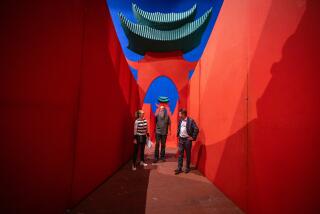CULTURE MONSTER
For several months in 2008, the Bird’s Nest in Beijing was the symbol of China’s emergence on the world stage. You couldn’t turn on a TV without being bombarded by fawning aerial shots of its lattice steelworks exterior.
How quickly fortunes turn. Since the Summer Games ended in August, the stadium has suffered a fate all too common among former Olympic venues worldwide: neglect. A lack of bookings means the building (designed by Herzog & de Meuron) remains empty most of the time. The stadium has lowered ticket prices to lure more tourists. Business is so meager, there are plans to turn parts of it into a shopping center.
So the recent news that Chinese auteur Zhang Yimou will restage his famous production of Puccini’s “Turandot” at the stadium in October comes as a noteworthy development. Zhang’s mega-production, originally staged at the Forbidden City in 1998, will include new and improved special effects in addition to the cast-of-thousands pageantry that marked its first outing.
In a larger sense, the revival of “Turandot” (meant to celebrate the Communist Party’s 60th anniversary in power) asks an important question: Can the performing arts revive interest in the stadium?
It’s a tricky proposition. The venue’s sheer size -- 90,000-plus seats -- renders it impractical for most art events. (And most sporting events too.) Could you imagine straining to hear “Hamlet” from the nosebleed seats? Or squinting to see the choreography of a dance troupe?
Still, size could work to its advantage. The owner -- a company called the Citic Group -- has stated its intention to bring in only prestige events. It’s just a question of programming the right material.
Bigger is not only better, it’s a requirement. So how about an original show by Cirque du Soleil? Beijing is teeming year-round with Western tourists, who would be the natural audience for such a spectacle. The outsized, hyper-colorful aesthetic that is Cirque’s trademark seems like a natural fit.
Another possibility: Bring in more opera stars. Classical music is big among China’s middle class, and its popularity is only growing. Promoters could import major talents, like Placido Domingo, for one-off concerts and safely expect a healthy turnout. Acoustics are nonexistent, of course. But that’s what sound systems are for.
And why limit it to the performing arts? Beijing’s thriving visual arts community could use the space for exhibitions and for showing large-scale work. In fact, one of the stadium’s designers was Ai Weiwei, the outspoken multimedia artist who specializes in grandiose creations. To see an exhibition of his work at the stadium he helped to create would be doubly remarkable.
--
--
latimes.com/culturemonster
For more arts coverage, visit the Culture Monster blog.
More to Read
The biggest entertainment stories
Get our big stories about Hollywood, film, television, music, arts, culture and more right in your inbox as soon as they publish.
You may occasionally receive promotional content from the Los Angeles Times.










